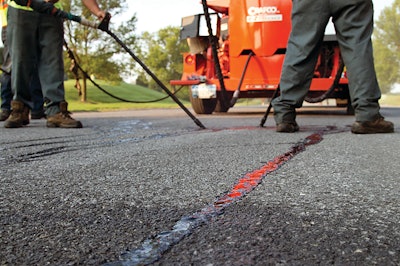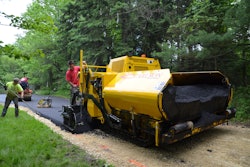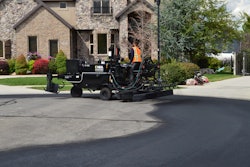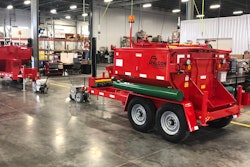
Crack sealing is the lowest-cost-with-highest-benefit pavement preservation treatment. But just because it’s economical doesn’t mean it can be left to chance. Proper sealant selection and installation are essential. Here are seven tips to get the most from your efforts.
1. Determine your target(s) and objectives. As effective as crack sealing is, it isn’t suitable for every type of pavement distress. Survey your target area(s) in advance. Assess types of cracking, widths of cracks (crack seal works best in cracks 1.5″ width or less), and topography issues, as well as vehicle loads/traffic. This will help you determine repair methodologies, crew, and equipment needs. Decide areas where you’ll apply crack sealant and what you’ll need to get it done. Is there vegetation to remove with a hot air lance? Are safety cones/signage required to protect workers from traffic? What types of tooling is appropriate? How much sealant will you use? Make sure to bring everything you need to the site at the start so you can get the job done efficiently.
2. Make sure all cracks are clean and dry. To ensure maximum adhesion and longevity, start with clean, dry cracks. Water is the enemy of pavement and crack sealant. If it’s rained recently — or precipitating now — schedule work for another day. If it’s dry enough, clean cracks thoroughly to remove rocks, weeds, and dirt that will affect work. Cleaning can be done with a wire broom, compressed air, or crack vacuum. You’ll also want to use a heat gun to make sure pavement is the right application temperature: 40°F and rising. If you notice excessive bubbling as you lay down sealant, that’s a sign of moisture and debris. Stop immediately and re-clean cracks before applying more material.
3. Rout, as appropriate. Routing before crack sealing can improve the likelihood of proper sealant adherence and double its service life! This practice creates fresh, uniform edges that help sealant adhere better and a reservoir to allow thermal movement. Still, not every project should be routed. If pavement has a crack density greater than 20%, or shows fatigue cracking or other severe distress, it may not be strong enough to sustain it. Crafco’s Model 30 Dust-Control Router is the perfect choice for performance and safety.
4. Use the correct sealant and maintain it properly. Sealant properties change by climate, ASTM type, viscosity, and more. As you select sealant, make sure it falls within approved spec, and that the sealant lot number is on hand in case there’s any issue. First, look at heating type. Indirect-fired and direct-fired sealants are not interchangeable. You must select them by your melter type. Next, if you swap sealant between jobs, remember to empty the tank completely before adding a different sealant, as mixing two sealants can change chemistry drastically. Finally, make sure to heat to manufacturer instructions and agitate sealant properly. Overheated or overworked material can break down, reducing pot life and causing adhesion issues. Underheated material won’t flow down to the depth of the crack. Avoid throwing in many blocks at one time, as this can reduce the temperature of the heated material in your tank and delay work. Add new material in the same amount that you’re laying it down to keep proper flow and application temperature. Too many blocks can also jam agitation paddles in certain melters.
5. Take care of your equipment. Having a good-quality melter will make your work better, easier, and safer. And maintained properly, it will last for years and perform at maximum efficiency. Simple mistakes such as adding too much sealant, driving with a full tank of sealant, or driving with the burner on can wreak havoc on your machine. Follow the manufacturer’s guidelines for care. This includes changing your hydraulic and heat transfer oils as recommended. Old heat transfer oil can crystallize and result in a very expensive and time-consuming repair.
6. Follow safety protocols. Crack sealing can be done on the quietest parking lot or busiest highway. Wherever it’s performed, make sure to use proper PPE, safety cones, and other tools to reduce any hazard. You can also enhance safety through your equipment. Melters with intuitive user interfaces and automated safety controls/shutoffs can be practical if you have an inexperienced crew or higher turnover.
7. Employ good techniques. Finally, how you apply sealant can make a huge difference. Use the technique that aligns with your objectives. Flush fill if an overlay or other surface treatment is planned in the near future. Overband 1/16 inch (maximum 1/8-inch thick, extending 1 inch on each side of the crack) on a standalone repair. Keep the overband tight to the pavement, watch your flow, and use a squeegee to shape and force sealant into cracks for optimum performance. Don’t use more sealant than necessary as it will be messy and reduce your pavement’s skid resistance. And never try to crack-seal potholes, alligator cracks, or wide cracks (larger than 1.5 inches wide). Errantly applied sealant looks unprofessional and can cost you hundreds or even thousands of dollars a year.
Select the Proper Sealant
There are basically five contributing factors that are to be considered with regards to sealant selection:
- Project Specifications
- Sealant Properties
- Climate
- Pavement Conditions
- Installation
Each different component will help you to determine which type of sealant will best suit your needs. Be sure to work closely with your sealant provider to make sure you’re meeting each of these considerations with your sealant selection.
Applying Specs, Sealant Properties to Selection
Project specifications are the number one factor influencing sealant selection. When the project specs are received, the climate and pavement condition should have already been considered by the agency, etc. ASTM specifications are the most frequently used in crack sealing projects. Once the ASTM standard is chosen, a sealer should also meet these general specifications:
- Approvals/Acceptance – Certain sealant materials are approved by the individual agencies or states. There may be more suitable sealants for the project, however these may not be used until they have been accepted by the agency or state.
- Availability/Lead Times – The material’s manufacturing and shipping timelines (or delays), may influence sealant selection. This would be relevant in relation to project deadlines or timelines.
- Product Cost – At times a variety of sealants may meet the specification with a range of price difference. The project budget will influence which sealant is selected based upon cost
- Project Goals/Expectations – Is it a short term solution? (i.e., hold a project together for the winter). Or long term solution (max life expected from the sealant since it may not ever have the benefit of an overlay).
Sealant Qualities to Consider
Materials used as crack sealants are subjected to a variety of stresses and other effects including horizontal expansion and contraction of the pavement as temperatures change from summer to winter, vertical movements as traffic passes, exposure to water from rain and snow, aging from environmental effects, and abrasion from traffic and highway maintenance operations (sweeping and snowplows).
Therefore, the sealant you choose should have these qualities:
- Adhesion: the ability to adhere and remain adhered to the pavement throughout the range of temperatures, movements, traffic, and other effects encountered.
- High Temperature Stability: the ability to remain in place and resist flow, tracking or pick-up by vehicle tires at hot summer temperatures.
- Low Temperature Flexibility/Elongation: the ability to stretch or extend at low temperatures experienced without cracking or de-bonding.
- Elasticity: the ability to restrict entrance of incompressible materials into the crack.
- Viscosity/Application Consistency: the ability to be effectively and easily applied to the crack through the application equipment.
- Aging Resistance: the ability to resist degradation from long term in service weathering .
- Curing: the ability to set up and reach final in-place properties quickly to permit opening of the pavement to traffic
- Pot Life: the ability to maintain physical properties during the time it takes for installation.
- Compatibility with Asphalt Concrete: the ability to not form an oily exudate and remain adhered when in contact with asphalt concrete.
Most important, make sure you have an adept sealant and equipment manufacturer who can provide support in the field. Smart planning along with these tips will ensure simple, effective crack sealing and great pavement performance for years to come.
Information for this article was provided by Crafco, Inc., Chandler, AZ; www.crafco.com









![Lee Boy Facility 2025 17 Use[16]](https://img.forconstructionpros.com/mindful/acbm/workspaces/default/uploads/2025/09/leeboy-facility-2025-17-use16.AbONDzEzbV.jpg?ar=16%3A9&auto=format%2Ccompress&fit=crop&h=135&q=70&w=240)








